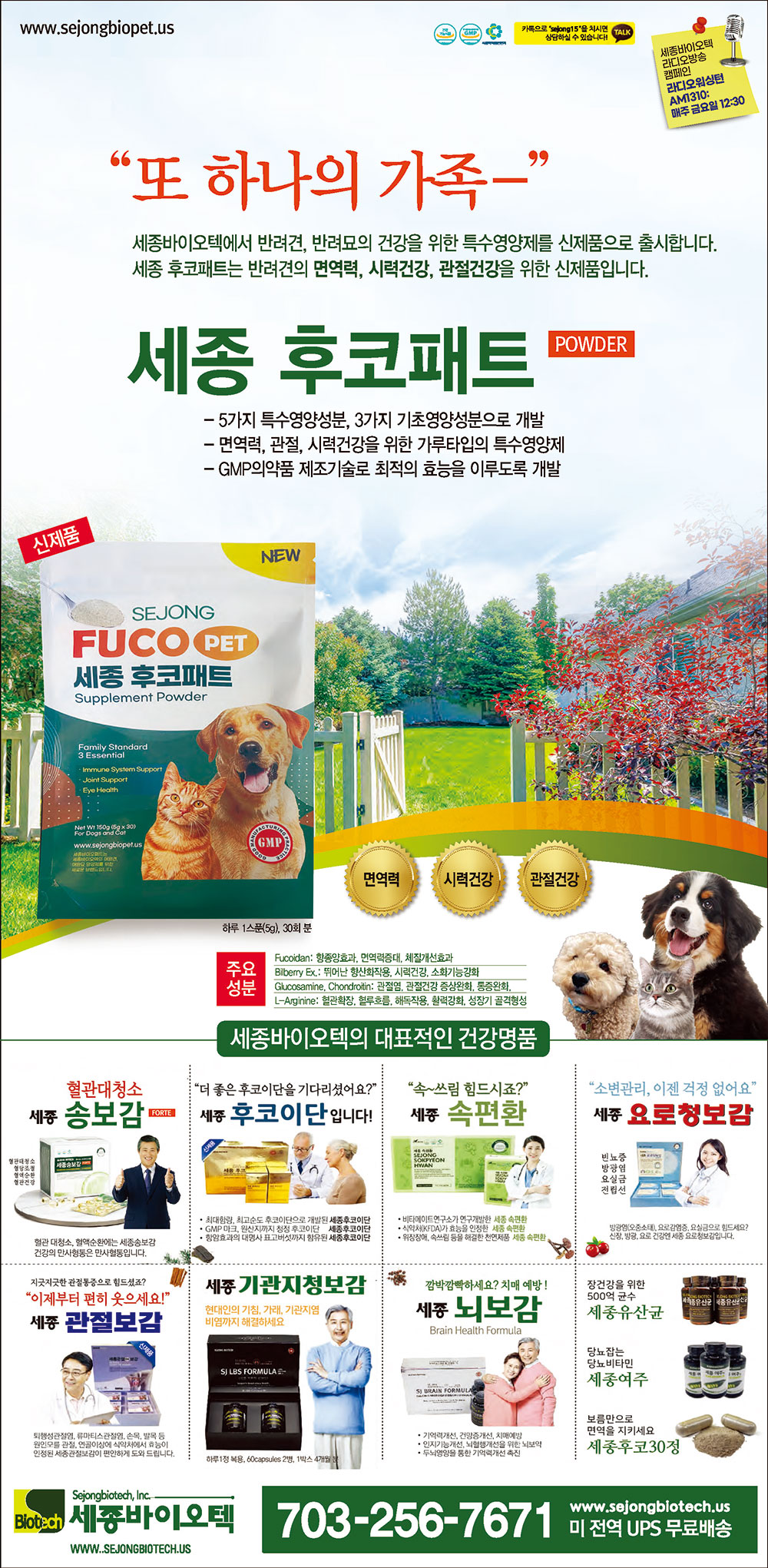
또 하나의 가족 세종 후코패트


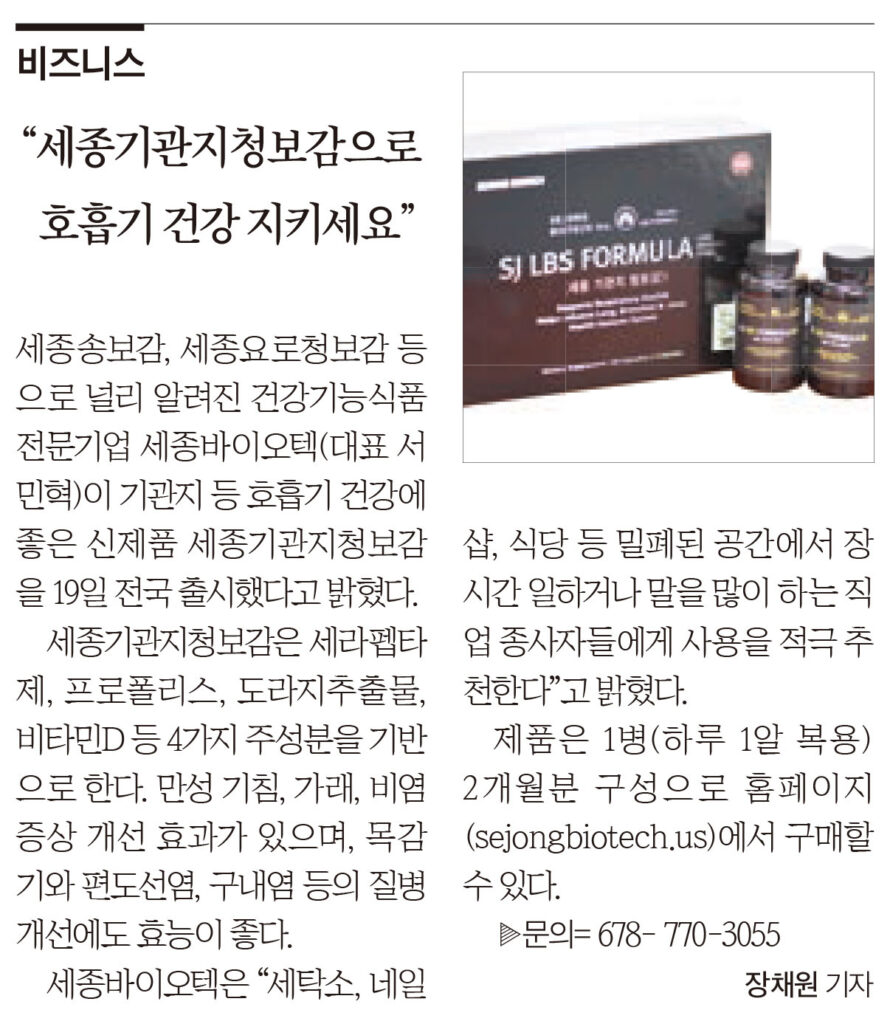
“세종기관지청보감으로 호흡기 건강 지키세요”
세종송보감, 세종요로청보감 등으로 널리 알려진 건강기능식품 전문기업 세종바이오텍(대표 서민혁)이 기관지 등 호흡기 건강에 좋은 신제품 세종기관지청보감을 19일 전국 출시했다고 밝혔다.
세종기관지청보감은 세라펩타제, 프로폴리스, 도라지추출물, 비타민D 등 4가지 주성분을 기반으로 한다. 만성 기침, 가래, 비염 증상 개선 효과가 있으며, 목감기와 편도선염, 구내염 등의 질병 개선에도 효능이 좋다.
세종바이오텍은 “세탁소, 네일샵, 식당 등 밀폐된 공간에서 장시간 일하거나 말을 많이 하는 직업 종사자들에게 사용을 적극 추천한다”고 밝혔다.
제품은 1병(하루 1알 복용) 2 개월분 구 성으 로 홈페이지(sejongbiotech.us)에서 구매할 수 있다.
문의= 678- 770-3055
중앙일보 장채원 기자

당뇨병 예방에 있어서 깨끗한 혈관의 중요한 역할
In the ongoing battle against diabetes, a condition that affects millions worldwide, medical researchers have uncovered a fascinating connection: the state of our blood vessels may hold the key to prevention. Diabetes, characterized by high blood sugar levels, can lead to severe health complications, including heart disease, kidney failure, and blindness. However, by understanding how clean blood vessels contribute to diabetes prevention, we can take proactive steps to safeguard our health.
전 세계적으로 수백만 명에게 영향을 미치는 질병인 당뇨병과의 지속적인 싸움에서 의학 연구자들은 흥미로운 연관성을 발견했습니다. 즉, 혈관 상태가 예방의 열쇠를 쥐고 있을 수 있다는 것입니다. 높은 혈당 수치를 특징으로 하는 당뇨병은 심장병, 신부전, 실명 등 심각한 건강상의 합병증을 유발할 수 있습니다. 그러나 깨끗한 혈관이 당뇨병 예방에 어떻게 기여하는지 이해함으로써 우리는 건강을 보호하기 위한 적극적인 조치를 취할 수 있습니다.
The Role of Clean Blood Vessels
깨끗한 혈관의 역할
Our blood vessels play a critical role in maintaining overall health. Arteries, veins, and capillaries form an intricate network responsible for transporting oxygen, nutrients, and immune cells throughout the body. When blood vessels become clogged with plaque—a mixture of cholesterol, fat, and other substances—they narrow, impeding blood flow and increasing the risk of various health problems, including diabetes.
우리의 혈관은 전반적인 건강을 유지하는 데 중요한 역할을 합니다. 동맥, 정맥, 모세혈관은 몸 전체에 산소, 영양분, 면역 세포를 운반하는 역할을 하는 복잡한 네트워크를 형성합니다. 혈관이 콜레스테롤, 지방 및 기타 물질의 혼합물인 플라크로 막히면 좁아지고 혈류를 방해하며 당뇨병을 포함한 다양한 건강 문제의 위험이 증가합니다.
Clean blood vessels, on the other hand, are free from such obstructions, allowing blood to flow smoothly and efficiently. This unimpeded circulation is essential for delivering insulin and glucose to cells, helping to regulate blood sugar levels. Moreover, clean blood vessels support the health of organs and tissues by ensuring adequate oxygen and nutrient supply.
반면 깨끗한 혈관은 이러한 방해물이 없어 혈액이 원활하고 효율적으로 흐를 수 있습니다. 이러한 방해받지 않는 순환은 인슐린과 포도당을 세포에 전달하는 데 필수적이며 혈당 수치를 조절하는 데 도움이 됩니다. 또한 깨끗한 혈관은 적절한 산소와 영양분 공급을 보장하여 장기와 조직의 건강을 지원합니다.
Preventing Diabetes Through Vascular Health
혈관 건강을 통한 당뇨병 예방
Maintaining clean blood vessels is integral to diabetes prevention. Several lifestyle factors contribute to vascular health, including:
깨끗한 혈관을 유지하는 것은 당뇨병 예방에 필수적입니다. 다음과 같은 여러 생활 방식 요인이 혈관 건강에 기여합니다.
Healthy Diet: Consuming a balanced diet rich in fruits, vegetables, whole grains, and lean proteins can help prevent the buildup of plaque in blood vessels. Limiting intake of processed foods, sugary snacks, and saturated fats is also crucial for vascular health.
건강한 식단: 과일, 채소, 통곡물, 저지방 단백질이 풍부한 균형 잡힌 식단을 섭취하면 혈관에 플라크가 쌓이는 것을 예방하는 데 도움이 될 수 있습니다. 가공식품, 단 스낵, 포화지방의 섭취를 제한하는 것도 혈관 건강에 중요합니다.
Regular Exercise: Physical activity promotes blood circulation and helps regulate blood pressure and cholesterol levels. Aim for at least 150 minutes of moderate-intensity exercise per week to support vascular health and reduce the risk of diabetes.
규칙적인 운동: 신체 활동은 혈액 순환을 촉진하고 혈압과 콜레스테롤 수치를 조절하는 데 도움이 됩니다. 혈관 건강을 유지하고 당뇨병 위험을 줄이려면 일주일에 최소 150분 동안 중간 강도의 운동을 하는 것을 목표로 하세요.
Weight Management: Excess body weight, especially abdominal fat, increases the risk of insulin resistance and diabetes. Maintaining a healthy weight through a combination of diet and exercise is essential for preventing vascular damage and diabetes.
체중 관리: 과도한 체중, 특히 복부 지방은 인슐린 저항성과 당뇨병의 위험을 증가시킵니다. 혈관 손상과 당뇨병을 예방하려면 식이요법과 운동을 병행하여 건강한 체중을 유지하는 것이 필수적입니다.
Smoking Cessation: Smoking damages blood vessels and accelerates the buildup of plaque, increasing the risk of vascular diseases and diabetes. Quitting smoking can significantly improve vascular health and reduce diabetes risk.
금연: 흡연은 혈관을 손상시키고 플라크의 축적을 가속화하여 혈관 질환 및 당뇨병의 위험을 증가시킵니다. 담배를 끊으면 혈관 건강이 크게 개선되고 당뇨병 위험이 줄어듭니다.
In conclusion, the condition of our blood vessels plays a crucial role in preventing diabetes. By maintaining clean, healthy arteries and veins through lifestyle modifications such as diet, exercise, and smoking cessation, we can reduce the risk of insulin resistance and diabetes. Understanding the intricate connection between vascular health and diabetes empowers us to take proactive steps towards better health outcomes. Let’s prioritize vascular health to safeguard against the growing epidemic of diabetes and its complications.
결론적으로, 당뇨병 예방에는 혈관 상태가 중요한 역할을 합니다. 식이요법, 운동, 금연 등 생활습관 개선을 통해 깨끗하고 건강한 동맥과 정맥을 유지함으로써 인슐린 저항성과 당뇨병의 위험을 줄일 수 있습니다. 혈관 건강과 당뇨병 사이의 복잡한 연관성을 이해하면 더 나은 건강 결과를 향한 적극적인 조치를 취할 수 있습니다. 늘어나는 당뇨병과 그 합병증을 예방하기 위해 혈관 건강을 최우선으로 생각합시다.
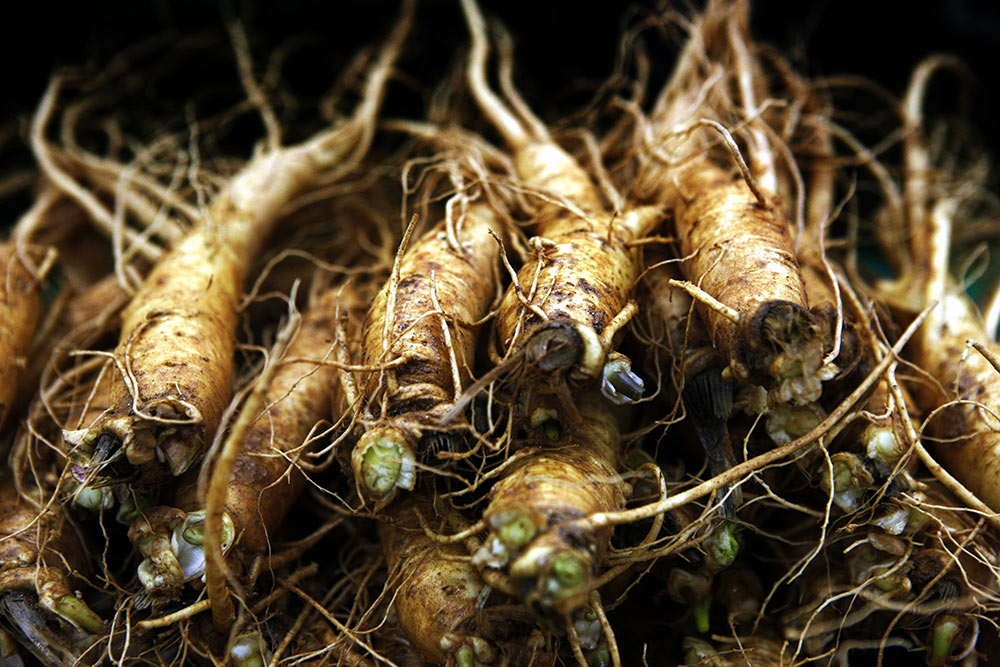
In the pursuit of good health, we often seek out remedies that are both effective and natural. One such remedy that has gained attention for its potential benefits to bronchial health is bellflower. Also known as Campanula, this flowering plant has been used in traditional medicine for centuries, and modern research is shedding light on its potential therapeutic properties. In this article, we’ll explore the effects of bellflower on bronchial health and its implications for respiratory wellness.
건강을 추구하면서 우리는 효과적이고 자연스러운 치료법을 찾는 경우가 많습니다. 기관지 건강에 대한 잠재적인 이점으로 주목을 받은 치료법 중 하나는 도라지입니다. 캄파눌라라고도 알려진 이 꽃 피는 식물은 수세기 동안 전통 의학에서 사용되어 왔으며 현대 연구에서는 캄파눌라의 잠재적인 치료 특성이 밝혀지고 있습니다. 이 기사에서는 도라지가 기관지 건강에 미치는 영향과 호흡기 건강에 미치는 영향을 살펴보겠습니다.
Understanding Bronchial Health: 기관지 건강 이해:
Before delving into the specifics of bellflower’s effects, it’s important to understand the significance of bronchial health. The bronchi are the main passageways that allow air to enter and exit the lungs. When these airways become inflamed or constricted, it can lead to respiratory issues such as coughing, wheezing, and difficulty breathing. Conditions like asthma, bronchitis, and chronic obstructive pulmonary disease (COPD) can all affect bronchial health, impacting one’s quality of life.
도라지의 구체적인 효능을 알아보기 전에 기관지 건강의 중요성을 이해하는 것이 중요합니다. 기관지는 공기가 폐로 들어오고 나가는 주요 통로입니다. 이러한 기도에 염증이 생기거나 수축되면 기침, 천명음, 호흡 곤란과 같은 호흡기 문제가 발생할 수 있습니다. 천식, 기관지염, 만성폐쇄성폐질환(COPD)과 같은 질환은 모두 기관지 건강에 영향을 주어 삶의 질에 영향을 줄 수 있습니다.
Exploring the Benefits of Bellflower: 도라지의 효능 살펴보기:
Bellflower has long been used in traditional medicine systems such as Traditional Chinese Medicine (TCM) and Ayurveda to treat respiratory ailments. Its potential benefits for bronchial health can be attributed to its rich array of bioactive compounds, including saponins, flavonoids, and phenolic acids.
도라지는 오랫동안 중국 전통 의학(TCM) 및 Ayurveda와 같은 전통 의학 시스템에서 호흡기 질환 치료에 사용되어 왔습니다. 기관지 건강에 대한 잠재적인 이점은 사포닌, 플라보노이드 및 페놀산을 포함한 풍부한 생리 활성 화합물에 기인할 수 있습니다.
Anti-inflammatory Properties: 항염증제 특성:
Inflammation plays a significant role in bronchial disorders, contributing to airway constriction and discomfort. Research suggests that bellflower exhibits anti-inflammatory properties that may help alleviate inflammation in the bronchial tubes. A study published in the Journal of Ethnopharmacology found that extracts of bellflower exhibited significant anti-inflammatory activity in animal models, supporting its traditional use for respiratory conditions.
염증은 기관지 장애에서 중요한 역할을 하며 기도 수축 및 불편함을 유발합니다. 연구에 따르면 도라지는 기관지의 염증을 완화하는 데 도움이 될 수 있는 항염증 특성을 나타내는 것으로 나타났습니다. Journal of Ethnopharmacology에 발표된 연구에 따르면 도라지 추출물은 동물 모델에서 상당한 항염증 활성을 나타냈으며 이는 호흡기 질환에 대한 전통적인 사용을 뒷받침합니다.
Expectorant Action: 거담제 작용:
One of the challenges in bronchial health is the accumulation of mucus in the airways, leading to congestion and difficulty breathing. Bellflower has been traditionally valued for its expectorant properties, which help loosen and expel mucus from the lungs. This can provide relief from coughing and improve respiratory function.
기관지 건강의 문제 중 하나는 기도에 점액이 축적되어 혼잡과 호흡 곤란을 초래하는 것입니다. 도라지는 폐에서 점액을 느슨하게 하고 배출하는 데 도움이 되는 거담 성분으로 전통적으로 높이 평가되어 왔습니다. 이를 통해 기침을 완화하고 호흡 기능을 향상시킬 수 있습니다.
Antioxidant Effects: 항산화 효과:
Oxidative stress is another factor that can contribute to bronchial inflammation and damage. Bellflower contains antioxidants that help neutralize harmful free radicals, protecting the respiratory system from oxidative damage. By reducing oxidative stress, bellflower may support overall bronchial health and respiratory function.
산화 스트레스는 기관지 염증 및 손상에 기여할 수 있는 또 다른 요인입니다. 도라지에는 유해한 자유 라디칼을 중화시키는 데 도움이 되는 항산화제가 함유되어 있어 호흡기계를 산화 손상으로부터 보호합니다. 산화 스트레스를 줄임으로써 도라지는 전반적인 기관지 건강과 호흡 기능을 지원할 수 있습니다.
In conclusion, bellflower holds potential as a natural remedy for promoting bronchial health and supporting respiratory wellness. Its anti-inflammatory, expectorant, and antioxidant properties make it a promising option for individuals seeking alternatives to conventional treatments for bronchial disorders. However, further research is needed to fully understand its mechanisms of action and optimal dosing strategies. As with any herbal remedy, it’s important to approach bellflower use with caution and seek guidance from a qualified healthcare provider. With proper precautions, bellflower may offer relief and support for individuals striving to maintain healthy bronchial function.
결론적으로, 도라지는 기관지 건강을 증진하고 호흡기 건강을 지원하는 자연 치료제로서의 잠재력을 가지고 있습니다. 항염증제, 거담제 및 항산화 특성으로 인해 기관지 장애에 대한 기존 치료법에 대한 대안을 찾는 개인에게 유망한 선택이 됩니다. 그러나 작용 메커니즘과 최적의 투여 전략을 완전히 이해하려면 추가 연구가 필요합니다. 모든 약초 요법과 마찬가지로 도라지 사용에 주의해서 접근하고 자격을 갖춘 의료 서비스 제공자의 지도를 구하는 것이 중요합니다. 적절한 예방 조치를 취하면 도라지는 건강한 기관지 기능을 유지하기 위해 노력하는 개인에게 안도감과 지원을 제공할 수 있습니다.
References:

In the world of natural health supplements, serrapeptase has been gaining attention for its potential benefits. But what exactly is serrapeptase, and how does it affect our health? Let’s dive into the science behind this enzyme and explore its impact on our well-being.
세라펩타제의 효능: 건강에 미치는 영향
천연 건강 보조식품 분야에서 세라펩타제는 잠재적인 이점으로 인해 주목을 받고 있습니다. 그렇다면 세라펩타제는 정확히 무엇이고, 우리 건강에 어떤 영향을 미칠까요? 이 효소 뒤에 숨은 과학에 대해 자세히 알아보고 이것이 우리의 웰빙에 미치는 영향을 살펴보겠습니다.
What is Serrapeptase?
Serrapeptase, also known as serratiopeptidase, is a proteolytic enzyme derived from the Serratia bacteria found in the intestines of silkworms. Initially discovered in the 1960s, serrapeptase has since been studied for its various health properties. It works by breaking down proteins into smaller fragments, which can then be easily eliminated from the body.
세라펩타제는 무엇입니까?
세라티오펩티다아제(serratiopeptidase)라고도 알려진 세라펩타아제(Serrapeptase)는 누에의 내장에서 발견되는 세라티아(Serratia) 박테리아에서 추출된 단백질 분해 효소입니다. 1960년대에 처음 발견된 세라펩타제는 이후 다양한 건강 특성에 대해 연구되어 왔습니다. 이는 단백질을 더 작은 조각으로 분해하여 작동하며, 신체에서 쉽게 제거될 수 있습니다.
Anti-Inflammatory Properties
One of the most well-known benefits of serrapeptase is its anti-inflammatory properties. Inflammation is a natural response by the body to injury or infection, but chronic inflammation can lead to various health problems, including cardiovascular disease, arthritis, and even cancer.
항염증 특성
세라펩타제의 가장 잘 알려진 이점 중 하나는 항염증 특성입니다. 염증은 부상이나 감염에 대한 신체의 자연스러운 반응이지만, 만성 염증은 심혈관 질환, 관절염, 심지어 암까지 포함한 다양한 건강 문제로 이어질 수 있습니다.
Several studies have shown that serrapeptase can help reduce inflammation by inhibiting certain molecules in the body that trigger inflammation. By doing so, serrapeptase may alleviate symptoms associated with inflammatory conditions like arthritis and sinusitis.
여러 연구에 따르면 세라펩타제는 염증을 유발하는 신체의 특정 분자를 억제하여 염증을 줄이는 데 도움이 될 수 있습니다. 그렇게 함으로써 세라펩타제는 관절염 및 부비동염과 같은 염증성 질환과 관련된 증상을 완화할 수 있습니다.
Pain Relief
In addition to its anti-inflammatory effects, serrapeptase has been studied for its potential to relieve pain. Research suggests that serrapeptase may help reduce pain by blocking the release of pain-inducing compounds in the body and promoting the breakdown of damaged tissue.
통증 완화
항염증 효과 외에도, 세라펩타제는 통증 완화 가능성에 대해 연구되었습니다. 연구에 따르면 세라펩타제는 신체에서 통증을 유발하는 화합물의 방출을 차단하고 손상된 조직의 파괴를 촉진하여 통증을 줄이는 데 도움이 될 수 있습니다.
Some studies have found that serrapeptase supplementation can lead to a significant reduction in pain intensity, particularly in individuals suffering from conditions such as osteoarthritis and carpal tunnel syndrome. By targeting the underlying causes of pain, serrapeptase offers a natural alternative to traditional pain medications with fewer side effects.
일부 연구에서는 세라펩타제 보충이 특히 골관절염 및 수근관 증후군과 같은 질환을 앓고 있는 개인의 통증 강도를 크게 감소시킬 수 있음을 발견했습니다. 통증의 근본 원인을 표적으로 삼아 세라펩타제는 부작용이 적은 전통적인 진통제에 대한 자연스러운 대안을 제공합니다.
Cardiovascular Health
Another area of interest regarding serrapeptase is its potential impact on cardiovascular health. Cardiovascular disease remains a leading cause of death worldwide, and finding effective ways to prevent and treat it is crucial.
심혈관 건강
세라펩타제에 관한 또 다른 관심 분야는 심혈관 건강에 대한 잠재적 영향입니다. 심혈관 질환은 전 세계적으로 여전히 주요 사망 원인으로 남아 있으며 이를 예방하고 치료하는 효과적인 방법을 찾는 것이 중요합니다.
Research suggests that serrapeptase may help improve cardiovascular health by breaking down arterial plaque and preventing blood clots. By reducing plaque buildup in the arteries, serrapeptase may improve blood flow and lower the risk of heart attack and stroke.
연구에 따르면 세라펩타제는 동맥 플라크를 분해하고 혈전을 예방하여 심혈관 건강을 개선하는 데 도움이 될 수 있습니다. 세라펩타제는 동맥의 플라크 축적을 줄임으로써 혈류를 개선하고 심장마비 및 뇌졸중의 위험을 낮출 수 있습니다.
Respiratory Support
Serrapeptase has also shown promise in providing respiratory support. Conditions such as chronic obstructive pulmonary disease (COPD) and cystic fibrosis can cause excessive mucus production and inflammation in the airways, leading to breathing difficulties.
호흡 지원
Serrapeptase는 또한 호흡 지원 제공에 대한 가능성을 보여주었습니다. 만성 폐쇄성 폐질환(COPD) 및 낭포성 섬유증과 같은 상태는 기도에서 과도한 점액 생성과 염증을 유발하여 호흡 곤란을 초래할 수 있습니다.
Studies have found that serrapeptase may help alleviate symptoms associated with respiratory conditions by breaking down mucus and reducing inflammation in the airways. This could potentially improve breathing and overall lung function in individuals with respiratory disorders.
연구에 따르면 세라펩타제는 점액을 분해하고 기도의 염증을 줄여 호흡기 질환과 관련된 증상을 완화하는 데 도움이 될 수 있습니다. 이는 호흡기 질환이 있는 개인의 호흡과 전반적인 폐 기능을 잠재적으로 향상시킬 수 있습니다.
In conclusion, serrapeptase is a powerful enzyme with various health benefits. From its anti-inflammatory and pain-relieving properties to its potential impact on cardiovascular and respiratory health, serrapeptase offers a natural alternative for promoting overall well-being.
결론적으로, 세라펩타제는 다양한 건강상의 이점을 지닌 강력한 효소입니다. 항염증 및 통증 완화 특성부터 심혈관 및 호흡기 건강에 대한 잠재적인 영향까지, 세라펩타제는 전반적인 웰빙을 촉진하기 위한 자연적인 대안을 제공합니다.
Incorporating serrapeptase into a healthy lifestyle may offer additional support for managing inflammation, pain, and other health concerns. With further research and understanding, serrapeptase could become a valuable tool in promoting optimal health and well-being.
세라펩타제를 건강한 생활 방식에 통합하면 염증, 통증 및 기타 건강 문제를 관리하는 데 추가적인 지원을 제공할 수 있습니다. 추가 연구와 이해를 통해 세라펩타제는 최적의 건강과 웰빙을 촉진하는 데 귀중한 도구가 될 수 있습니다.
References:
Panagariya A, et al. A preliminary trial of serratiopeptidase in patients with carpal tunnel syndrome. J Assoc Physicians India. 2000;48(11):1130-2.
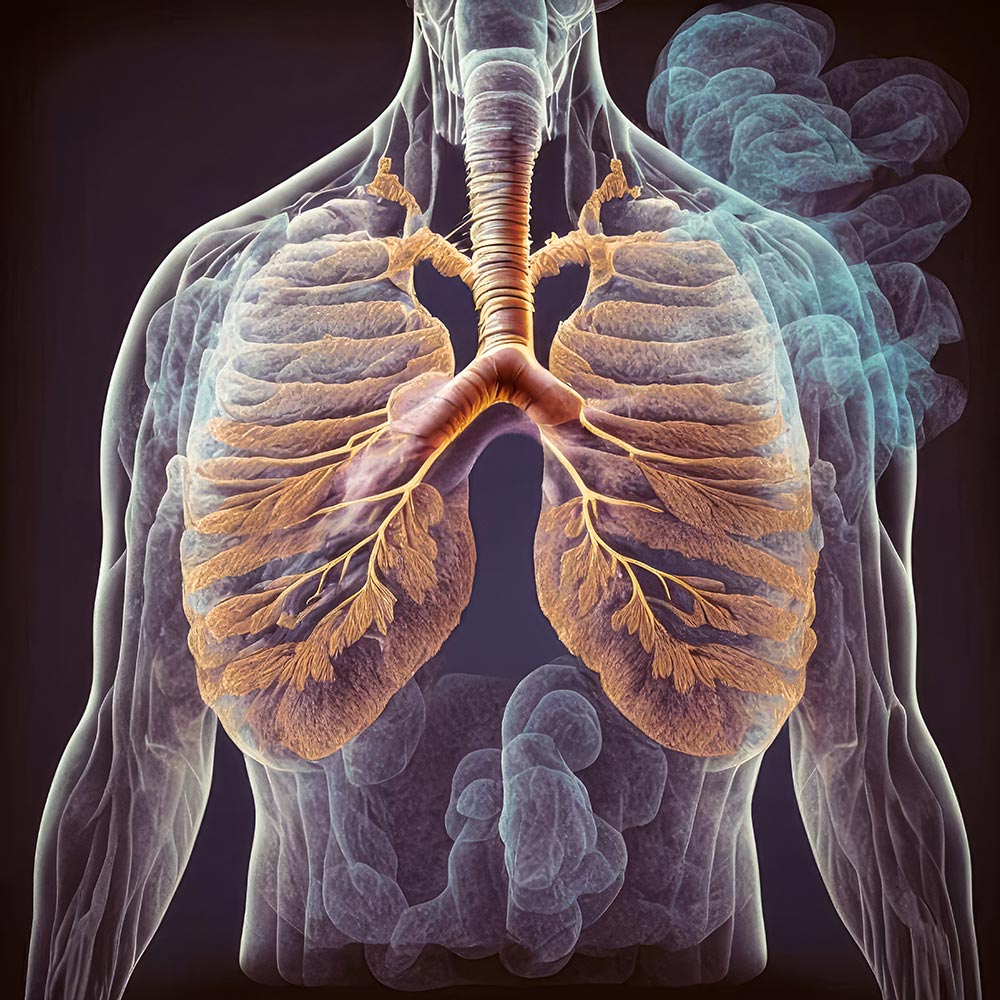
In the quest for longevity and well-being, we often overlook the critical role of our respiratory system, particularly the health of our bronchi. These vital airways play a crucial role in ensuring the smooth passage of air to and from the lungs, facilitating the exchange of oxygen and carbon dioxide essential for sustaining life. Emerging research underscores a profound connection between bronchus health and longevity, shedding light on the importance of nurturing our respiratory well-being for a longer, healthier life.
기관지 건강과 장수의 연관성: 생명의 호흡에 대한 이해
장수와 웰빙을 추구하는 과정에서 우리는 호흡기계의 중요한 역할, 특히 기관지의 건강을 간과하는 경우가 많습니다. 이러한 중요한 기도는 폐로 공기가 원활하게 통과하도록 보장하고 생명 유지에 필수적인 산소와 이산화탄소의 교환을 촉진하는 데 중요한 역할을 합니다. 새로운 연구는 기관지 건강과 장수 사이의 심오한 연관성을 강조하며, 더 길고 건강한 삶을 위해 호흡 복지를 육성하는 것의 중요성을 조명합니다.
The Anatomy of the Bronchi: Gateways to Vitality
Before delving into the relationship between bronchus health and longevity, it is essential to grasp the anatomy and function of these pivotal air passages. The bronchi are the primary conduits through which air travels from the trachea into the lungs. They branch off from the trachea, further dividing into smaller tubes known as bronchioles, which ultimately terminate in tiny air sacs called alveoli. This intricate network facilitates the exchange of gases, enabling oxygen to enter the bloodstream while expelling carbon dioxide.
기관지의 해부학: 활력의 관문
기관지 건강과 장수 사이의 관계를 탐구하기 전에, 이러한 중추적인 공기 통로의 해부학적 구조와 기능을 이해하는 것이 필수적입니다. 기관지는 공기가 기관에서 폐로 이동하는 주요 도관입니다. 그들은 기관에서 갈라져 세기관지라고 알려진 더 작은 관으로 더 나뉘며, 궁극적으로 폐포라고 불리는 작은 기낭에서 끝납니다. 이 복잡한 네트워크는 가스 교환을 촉진하여 이산화탄소를 배출하는 동시에 산소가 혈류로 들어갈 수 있도록 합니다.
Bronchial Health: A Barometer of Longevity
Studies have illuminated a compelling association between bronchus health and longevity. Chronic respiratory conditions, such as asthma, chronic obstructive pulmonary disease (COPD), and bronchitis, not only compromise respiratory function but also pose significant risks to overall health and longevity. Individuals afflicted with these conditions often experience reduced lung capacity, impaired oxygenation, and heightened susceptibility to respiratory infections, exacerbating their risk of mortality.
기관지 건강: 장수의 바로미터
연구에 따르면 기관지 건강과 장수 사이의 강력한 연관성이 밝혀졌습니다. 천식, 만성 폐쇄성 폐질환(COPD), 기관지염과 같은 만성 호흡기 질환은 호흡 기능을 손상시킬 뿐만 아니라 전반적인 건강과 수명에 심각한 위험을 초래합니다. 이러한 질환을 앓고 있는 개인은 종종 폐활량 감소, 산소 공급 장애, 호흡기 감염에 대한 민감성 증가를 경험하여 사망 위험을 악화시킵니다.
또한 대기오염, 담배연기, 산업재해 등의 환경적 요인은 기관지 건강에 상당한 피해를 주어 노화를 가속화하고 기대수명을 단축시킬 수 있습니다. 공기 중 오염 물질 및 독성 물질에 장기간 노출되면 기관지 내 염증, 산화 스트레스 및 조직 손상이 유발되어 호흡기 질환이 발생하고 전반적인 건강이 손상될 수 있습니다.
Moreover, environmental factors, including air pollution, tobacco smoke, and occupational hazards, can inflict considerable damage on bronchial health, accelerating the aging process and diminishing life expectancy. Prolonged exposure to airborne pollutants and toxic substances can trigger inflammation, oxidative stress, and tissue damage within the bronchi, paving the way for respiratory ailments and compromising overall health.
또한 대기오염, 담배연기, 산업재해 등의 환경적 요인은 기관지 건강에 상당한 피해를 주어 노화를 가속화하고 기대수명을 단축시킬 수 있습니다. 공기 중 오염 물질 및 독성 물질에 장기간 노출되면 기관지 내 염증, 산화 스트레스 및 조직 손상이 유발되어 호흡기 질환이 발생하고 전반적인 건강이 손상될 수 있습니다.
Nurturing Bronchial Wellness: Strategies for Longevity
Given the pivotal role of bronchial health in longevity, adopting proactive measures to safeguard respiratory well-being is paramount. Embracing a lifestyle characterized by regular exercise, a balanced diet, and avoidance of respiratory irritants can fortify bronchial resilience and enhance overall longevity. Engaging in aerobic activities strengthens respiratory muscles, improves lung function, and promotes optimal oxygenation, thereby bolstering bronchial health and vitality.
Furthermore, prioritizing indoor air quality by minimizing exposure to indoor pollutants, investing in air purifiers, and ensuring adequate ventilation can mitigate respiratory risks and foster a healthier living environment. Smoking cessation initiatives, coupled with public health campaigns aimed at raising awareness of the deleterious effects of tobacco smoke, are instrumental in curbing bronchial diseases and promoting longevity on a societal level.
기관지 건강 증진: 장수를 위한 전략
장수에 있어 기관지 건강의 중추적인 역할을 고려할 때, 호흡기 건강을 보호하기 위한 사전 조치를 취하는 것이 무엇보다 중요합니다. 규칙적인 운동, 균형 잡힌 식단, 호흡기 자극 물질을 피하는 등의 생활 방식을 수용하면 기관지 탄력성을 강화하고 전반적인 수명을 연장할 수 있습니다. 유산소 활동을 하면 호흡 근육이 강화되고, 폐 기능이 향상되며, 최적의 산소 공급이 촉진되어 기관지 건강과 활력이 강화됩니다.
또한 실내 오염 물질에 대한 노출을 최소화하고 공기 청정기에 투자하며 적절한 환기를 보장하여 실내 공기 질을 우선시하면 호흡기 위험을 완화하고 건강한 생활 환경을 조성할 수 있습니다. 담배 연기의 해로운 영향에 대한 인식을 제고하기 위한 공중 보건 캠페인과 결합된 금연 계획은 기관지 질환을 억제하고 사회적 차원에서 장수를 촉진하는 데 중요한 역할을 합니다.
Breathing Life into Longevity
In conclusion, the relationship between bronchus health and longevity is undeniable, underscoring the profound impact of respiratory well-being on overall vitality and lifespan. By cultivating a lifestyle conducive to optimal bronchial health and implementing preventive measures to mitigate respiratory risks, individuals can enhance their prospects for a longer, healthier life. Moreover, concerted efforts at the societal level, including environmental conservation and public health interventions, are imperative in safeguarding bronchial wellness and fostering longevity for generations to come.
장수에 생명을 불어넣다
결론적으로, 기관지 건강과 장수 사이의 관계는 부인할 수 없으며, 이는 호흡기 복지가 전반적인 활력과 수명에 미치는 중대한 영향을 강조합니다. 최적의 기관지 건강에 도움이 되는 생활방식을 기르고 호흡기 위험을 완화하기 위한 예방 조치를 시행함으로써 개인은 더 길고 건강한 삶에 대한 전망을 높일 수 있습니다. 더욱이 기관지의 건강을 보호하고 다음 세대의 장수를 촉진하려면 환경 보존과 공중 보건 개입을 포함한 사회 차원의 공동 노력이 필수적입니다.
References:
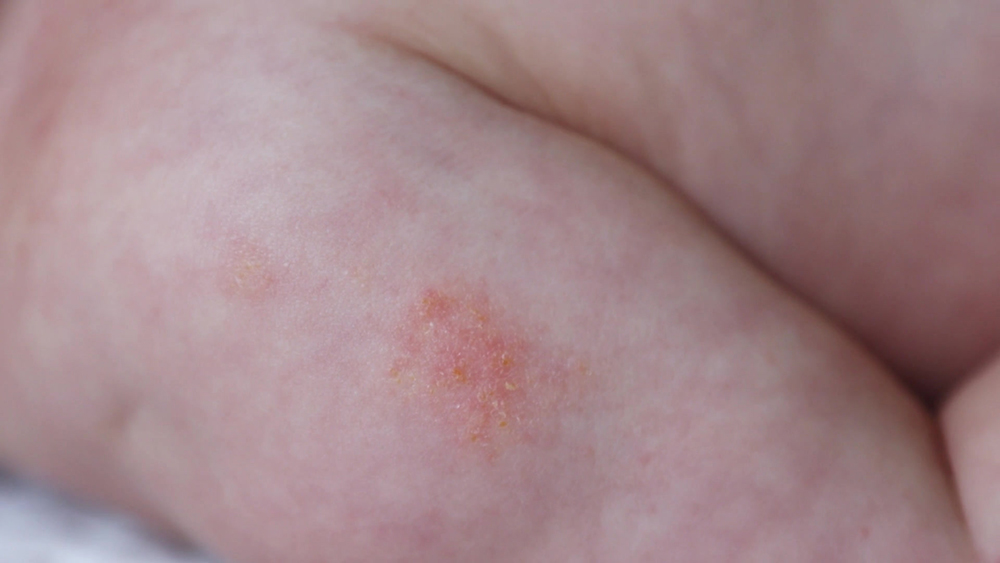
In the bustling world of health and wellness, the quest for effective, natural remedies to combat allergies and atopy is ever-growing. One promising avenue that has gained attention in recent years is the use of fucoidan, a bioactive compound found in certain seaweeds. This article aims to explore the potential benefits of fucoidan in preventing and improving atopy and allergies, shedding light on the science behind its actions.
Understanding Atopy and Allergies
Before delving into the role of fucoidan, let’s first grasp the basics of atopy and allergies. Atopy is a genetic tendency to develop allergic diseases, such as asthma, eczema, and allergic rhinitis. Allergies, on the other hand, occur when the immune system reacts excessively to a harmless substance, triggering symptoms ranging from sneezing and itching to more severe reactions.
The Immune System’s Role
To comprehend how fucoidan comes into play, it’s crucial to understand the immune system’s role in allergies. Allergic reactions are essentially a hypersensitive response of the immune system to certain stimuli, known as allergens. These allergens can be anything from pollen and pet dander to specific foods.
Fucoidan’s Immunomodulatory Properties
Fucoidan stands out for its unique immunomodulatory properties, meaning it can regulate and modulate the immune system’s responses. Several studies have indicated that fucoidan can help balance the immune system, preventing it from overreacting to harmless substances and thus reducing the severity of allergic reactions.
Research Findings
A study published in the “Journal of Immunology Research” (Choi et al., 2019) investigated the effects of fucoidan on allergic inflammation. The findings suggested that fucoidan exhibited anti-allergic and anti-inflammatory properties, reducing the production of inflammatory markers and mitigating allergic responses. This promising research opens doors to the potential use of fucoidan as a natural remedy for allergies and atopy.
Skin Health and Eczema
One of the most common manifestations of atopy is eczema, a skin condition characterized by red, itchy, and inflamed skin. Fucoidan’s skin-friendly properties make it a compelling candidate for addressing eczema. A study in the “Journal of Dermatological Science” (Lee et al., 2018) explored the effects of fucoidan on atopic dermatitis, revealing that fucoidan not only reduced inflammation but also promoted skin barrier function, making it a promising option for those dealing with eczema.
Antioxidant and Anti-Inflammatory Actions
Fucoidan’s benefits extend beyond its immunomodulatory effects. It also boasts potent antioxidant and anti-inflammatory actions, which play a crucial role in alleviating allergy symptoms. Antioxidants combat oxidative stress, a common trigger for allergic reactions, while anti-inflammatory properties help reduce the overall inflammatory response.
Conclusion
As we navigate the vast landscape of health and wellness, it’s heartening to discover natural compounds like fucoidan that hold promise in preventing and improving atopy and allergies. While more research is needed to fully understand the mechanisms and optimize dosages, the existing body of evidence suggests that fucoidan’s immunomodulatory, anti-inflammatory, and antioxidant properties make it a noteworthy candidate for those seeking alternative approaches to allergy management.
Incorporating fucoidan into one’s wellness routine may offer a holistic and natural solution to the challenges posed by atopy and allergies. As always, it’s advisable to consult with healthcare professionals before making significant changes to one’s health regimen. Embracing the potential of fucoidan is a step towards a future where the treasures of the sea contribute to our overall well-being in the fight against allergic ailments.

In the kaleidoscope of nutritional gems available in the world of food, shiitake mushrooms stand out not just for their distinctive flavor but for their potential to be a game-changer in supporting our health. Beyond their umami-packed goodness, these fungi harbor a host of benefits that make them an exciting addition to your plate. Let’s delve into the science-backed health benefits of shiitake mushrooms and explore how these humble fungi might be a secret weapon in your journey to well-being.
A Nutrient Powerhouse
Before we dive into the specific health benefits, let’s take a moment to appreciate the nutrient richness of shiitake mushrooms. These fungi are not just a tasty addition to your stir-fry; they’re a nutrient powerhouse. A 100-gram serving provides a healthy dose of B-vitamins, including riboflavin, niacin, pantothenic acid, pyridoxine, and folate. These B-vitamins play a crucial role in energy metabolism and are essential for maintaining a healthy nervous system1.
Shiitake mushrooms are also a fantastic source of minerals like copper, selenium, manganese, and zinc. These minerals contribute to various bodily functions, including immune support, antioxidant defense, and bone health1.
Boosting the Immune System
One of the standout qualities of shiitake mushrooms is their potential to give our immune system a boost. The secret lies in compounds like beta-glucans found in these mushrooms. Beta-glucans are polysaccharides known for their immunomodulatory effects, meaning they can help regulate and enhance the immune system’s response2.
Research has shown that regular consumption of shiitake mushrooms can lead to increased production of antiviral proteins, indicating a potential strengthening of the immune system2. In a world where maintaining robust immunity is crucial, incorporating shiitake mushrooms into your diet might be a tasty and natural way to give your body an extra layer of defense.
Heart Health and Cholesterol Control
The health of our cardiovascular system is paramount, and shiitake mushrooms may play a role in supporting heart health. Eritadenine, a compound found in shiitakes, has been linked to cholesterol regulation. Studies suggest that eritadenine may inhibit an enzyme involved in cholesterol synthesis, potentially leading to lower levels of LDL (low-density lipoprotein) cholesterol3.
In addition, a review published in the “Journal of Obesity and Metabolic Syndrome” pointed towards the potential of shiitake mushrooms in preventing obesity-related metabolic disorders, including dyslipidemia3. While more research is needed to fully grasp the mechanisms at play, these findings hint at the possibility that shiitakes could be a heart-healthy addition to your diet.
Antioxidant Defense
Shiitake mushrooms are not just defenders of the immune system; they also double as potent antioxidants. Antioxidants are substances that help neutralize free radicals – unstable molecules that, if left unchecked, can contribute to aging and various diseases4.
Ergothioneine and polyphenols, both present in shiitake mushrooms, contribute to their antioxidant prowess. These compounds help protect our cells from oxidative stress and inflammation, promoting overall health4.
Incorporating Shiitake Mushrooms Into Your Diet
Now that we’re armed with the knowledge of the health benefits, let’s talk about how to make shiitake mushrooms a delightful and regular part of your diet. From stir-fries and salads to soups and grilled delights, there’s no shortage of ways to enjoy these fungi. Their unique flavor profile allows them to seamlessly integrate into various dishes, making them a versatile ingredient for both culinary enthusiasts and those who prefer simpler recipes.
In conclusion, the health benefits of shiitake mushrooms extend far beyond their delectable taste. With a nutrient profile that reads like a multivitamin and scientific studies supporting their immune-boosting, heart-loving, and antioxidant-rich qualities, shiitake mushrooms deserve a place on your plate.
As you embark on your journey towards better health, consider this culinary secret from nature. By savoring the rich, earthy taste of shiitake mushrooms, you’re not just treating your taste buds – you’re providing your body with a powerful dose of wellness.
So, the next time you’re in the kitchen, remember the potential of shiitake mushrooms to be more than just an ingredient; they might be the key to unlocking a healthier, happier you.
References:
Footnotes
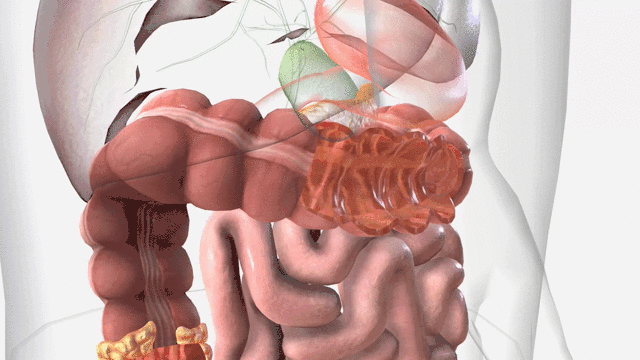
As we age, maintaining optimal health becomes a priority, and one often overlooked aspect is gut health. The trillions of microorganisms residing in our digestive system play a crucial role in overall well-being. In recent years, probiotics have gained significant attention for their potential to support a healthy gut, and their benefits for the elderly are particularly noteworthy. In this blog, we will explore why probiotics are essential for the well-being of elderly individuals, examining their impact on digestive health, immunity, and overall longevity.
Understanding Probiotics:
Probiotics are live microorganisms, primarily bacteria and yeast, that confer health benefits to the host when consumed in adequate amounts. Found in various fermented foods like yogurt, kefir, sauerkraut, and in supplement form, probiotics are known to promote a balanced microbial environment in the gut. The gut microbiota, often referred to as the “forgotten organ,” plays a crucial role in nutrient absorption, immune function, and even mental health.
Digestive Health and Probiotics:
As individuals age, changes in the gut microbiota composition occur, leading to a decline in beneficial bacteria and an increase in harmful ones. This imbalance can contribute to digestive issues such as constipation, bloating, and a decreased ability to absorb nutrients from food. Probiotics work by restoring this balance, promoting the growth of beneficial bacteria and inhibiting the harmful ones. Several studies have indicated that regular consumption of probiotics can alleviate common digestive problems in the elderly, enhancing overall gastrointestinal function.
Boosting Immunity:
One of the key advantages of probiotics for the elderly lies in their ability to support a robust immune system. As we age, the immune system tends to weaken, making individuals more susceptible to infections and illnesses. Probiotics play a pivotal role in modulating the immune response, promoting the production of antibodies and enhancing the activity of immune cells. Research suggests that incorporating probiotics into the diet can reduce the incidence and duration of respiratory infections and other common illnesses among the elderly.
Improving Nutrient Absorption:
In elderly individuals, issues with nutrient absorption can lead to deficiencies in essential vitamins and minerals, contributing to a range of health problems. Probiotics aid in the breakdown of complex molecules, facilitating the absorption of nutrients in the gut. This is particularly crucial for the elderly, as it can help mitigate the risk of malnutrition and associated complications.
Cognitive Health and Probiotics:
Recent studies have also explored the connection between gut health and cognitive function. The gut-brain axis, a bidirectional communication system between the gut and the brain, is influenced by the microbiota. Probiotics may have a positive impact on cognitive health by modulating inflammation and producing neuroactive compounds. While more research is needed to fully understand this complex relationship, the potential implications for preventing cognitive decline in the elderly are promising.
In conclusion, the incorporation of probiotics into the daily routine of elderly individuals can be a game-changer for their overall health and well-being. From supporting digestive health and enhancing nutrient absorption to bolstering the immune system and potentially influencing cognitive function, the benefits of probiotics are multifaceted. As the scientific community continues to unravel the mysteries of the gut microbiota, it’s clear that promoting a healthy balance of microorganisms through probiotics is a simple yet powerful strategy for promoting a vibrant and fulfilling life in our golden years.
References:

Cancer, a formidable adversary, has spurred intensive research into new treatments. One promising avenue in the quest to fight cancer is fucoidan, a natural compound extracted from brown seaweed. This blog will explore the potential of fucoidan in targeting and destroying cancer cells, offering insights into its mechanisms and providing a glimpse into its role as a complementary approach in the fight against cancer.
Understanding Fucoidan
Fucoidan is a sulfated polysaccharide, a complex carbohydrate derived from various species of brown seaweed. It has gained attention for its potential anti-cancer properties, sparking interest and research into its role in treating cancer. Here’s a closer look at fucoidan’s potential in killing cancer cells:
Research suggests that fucoidan exhibits anti-cancer effects by inhibiting the growth and proliferation of cancer cells. It may also induce apoptosis, a process of programmed cell death in cancer cells, effectively “killing” them.
The growth of tumors is dependent on the formation of new blood vessels, a process called angiogenesis. Fucoidan may inhibit angiogenesis, thus cutting off the blood supply to tumors and preventing their growth.
Fucoidan has been linked to the activation of natural killer (NK) cells and other immune cells, enhancing the body’s ability to identify and eliminate cancer cells.
Cancer cells thrive in an oxidative environment. Fucoidan’s antioxidant effects can help protect normal cells and reduce oxidative stress, potentially undermining the survival of cancer cells.
The Promise of Fucoidan in Targeting and Destroying Cancer Cells
While fucoidan’s role in the battle against cancer is promising, it’s important to remember that it is not a standalone cure. Cancer treatment is complex and multifaceted, often requiring a combination of therapies, including surgery, chemotherapy, radiation, and immunotherapy.
What makes fucoidan a valuable addition to these treatment modalities is its unique approach to targeting and destroying cancer cells. Fucoidan’s potential to inhibit cancer cell growth, induce apoptosis, prevent angiogenesis, and modulate the immune system contributes to its growing reputation as a complementary therapy.
In recent years, fucoidan-based products, such as dietary supplements and topical applications, have gained popularity, providing convenient options for those interested in incorporating this natural compound into their treatment regimen. However, it’s important for patients to consult with their healthcare providers before adding any new treatment to their existing cancer care plan.
The Road Ahead: Ongoing Research and Possibilities
The promising results of studies on fucoidan’s anti-cancer properties have paved the way for ongoing research. Researchers are delving deeper into understanding fucoidan’s mechanisms and exploring its potential as a cancer therapy. Clinical trials and laboratory experiments continue to unveil the compound’s impact on different types of cancer and its safety and efficacy in a medical context.
As research progresses, we may witness fucoidan’s integration into mainstream cancer treatment protocols, potentially improving patient outcomes and quality of life. However, for now, it remains an area of interest and an avenue of hope in the fight against this relentless disease.
Fucoidan as a Complementary Approach
It’s important to note that fucoidan is not a standalone cancer treatment. Instead, it is emerging as a complementary approach to existing cancer therapies. Fucoidan’s potential in targeting and destroying cancer cells makes it a valuable addition to the ongoing battle against this devastating disease.
Conclusion
Cancer continues to be a significant global health challenge, demanding innovative approaches to treatment. Fucoidan, a natural compound derived from brown seaweed, offers promise in the fight against cancer. Its anti-cancer, anti-angiogenic, immunomodulatory, and antioxidant properties have captured the attention of researchers.
While not a replacement for traditional cancer treatments, fucoidan can serve as a valuable ally in the battle against cancer. As research continues to unravel its mechanisms and potential, it may offer new hope to cancer patients and become a vital component of the comprehensive strategy against this formidable foe.
References: